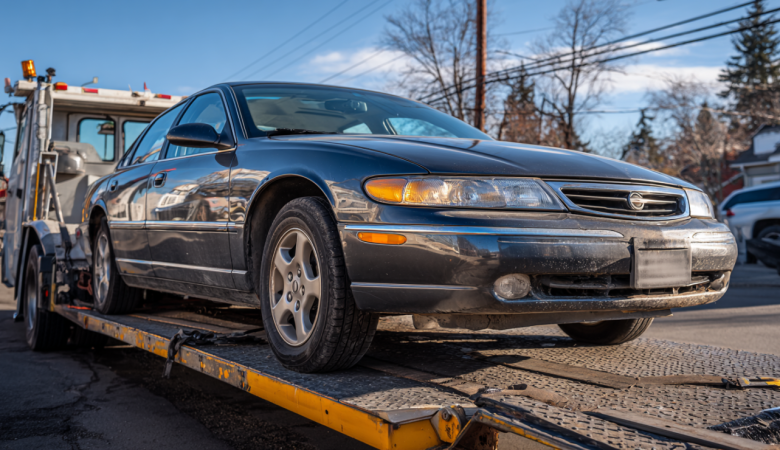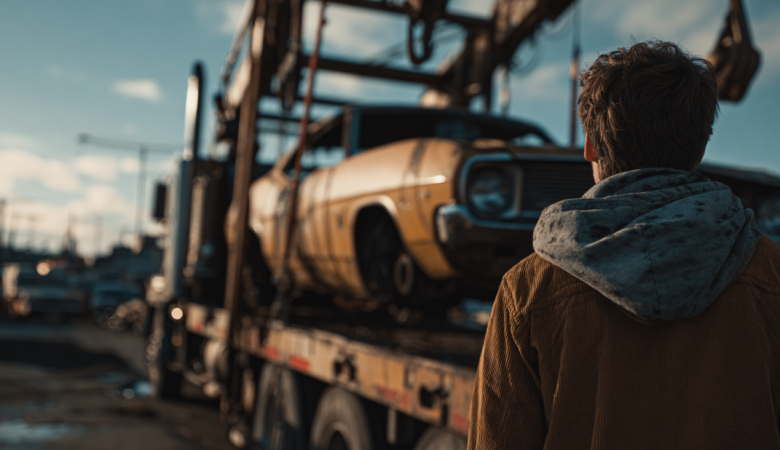Flooding can cause serious harm to your vehicle’s body and systems. If your car has been in a flood, it will need extra care before shipping. At EasyHaul, we guide you through each step of preparing a flood-damaged car so that shipping an auto goes smoothly.
In this guide, we’ll explain how to dry, clean, and document water-damaged cars and secure them for transport. By following these steps, you can protect your vehicle and avoid delays or extra fees.
1. Assess the Damage
Inspect flood-damaged vehicles for rust, mold, and wiring issues. Inspecting damaged vehicles early reduces risk. Signs of automobile flood damage include musty odors, mud staining, and warped panels. A flood vehicle may carry unseen electrical issues under the dash. Parts submerged in water require full drying before sealing. Minor car flood damage may be reversible with cleaning. If your car has been in a flood, check the oil and transmission fluid for water contamination.
2. Clean and Dry Thoroughly
Remove flood water from the cabin with wet vacuums and drying agents. Use fans and dehumidifiers inside cabins to prevent mold growth in water-flood vehicles. Before you load the trailer, rinse the flooded car exterior to remove salt or debris. Clear out all debris, mud, and groundwater residue. When dealing with water-damaged cars, moisture can hide in panels and carpet.
3. Document Condition and Titles
Before transfer, confirm the car has a clean title to avoid hold-ups. A flooded title flags a vehicle as previously damaged and may affect resale. Gather motor vehicle title information early to streamline paperwork. Record the vehicle identification number (VIN) on paperwork to match shipment labels. Verify status online via the vehicle title information system if available. Check records in the national motor vehicle title registry to confirm history. Fill out each field on the vehicle’s title form correctly to prevent errors. Every flood-damaged car should be fully detailed and photographed before pickup.
4. Secure Electrical and Mechanical Components
Shield the electrical components from corrosion by applying approved protective sprays. Check all electrical systems for shorts, cracks, or loose connectors. Disconnect the battery to prevent drainage or sparks during transport. Secure loose parts like the spare tire in its mount to avoid damage. Take flood-damaged cars to a certified shop for a full evaluation.
5. Choose the Right Transport Service
Compare quotes from top auto transport companies to find your best option. Vehicle transportation rates vary by distance and service level. Reputable firms for shipping vehicles offer secure options like open or enclosed carriers. The shipping automobile process starts with a quote and a deposit to confirm your slot. Shipping an automobile often requires scheduling a pickup slot at least a week in advance. For car transportation, you may want door-to-door service to simplify logistics. To ship a vehicle, you must meet all loading guidelines and weight limits.
6. Prepare the Vehicle for Loading
Many flooded cars hide moisture in hidden cavities. Before loading, ensure all doors, windows, and latches work properly. Secure loose items inside the cabin and remove personal belongings. Excess water in floor mats can damage other shipments, so remove mats if soaked. Carry documentation including shipment paperwork, title, and a detailed inventory. Special straps keep water-flood-damaged vehicles stable during transit. A flooded car often needs extra padding to support weakened body panels.
7. Final Tips and Money-Saving Strategies
Booking early can save money by avoiding peak-season rates. If you plan on buying a car post-flood, consult a mechanic with flood experience. Insurance companies often inspect the aftermath, so photograph every panel and interior before pickup. Classic car owners should consider enclosed trailers to protect paint and trim. Ask your car shipping company about discounts for multiple vehicles or referrals.
Frequently Asked Questions
Q: Can I ship a vehicle that has mold inside?
A: Yes, but it must be cleaned thoroughly (if possible) and documented in the damage report.
Q: Will flood cars move differently on a trailer?
A: No, but securing them properly is critical to prevent shifting and damage.
Q: How long does the drying process take?
A: Drying time varies by humidity and temperature, but plan for at least 24 to 48 hours.
Q: Are there extra fees for water-damaged vehicles?
A: Some carriers charge more for flooded cars due to added handling and insurance costs, along with biohazard exposure.
Q: What should I look for in my vehicle history report?
A: Confirm that the report does not list cars with water-flood damage as totaled or salvage.
Final Thoughts
Preparing a flood-damaged car for shipping demands thorough cleaning, documentation, and secure transport planning. EasyHaul handles damaged vehicles of all conditions and ensures every step meets our safety standards. We accept flooded vehicles that meet our prep standards and trust EasyHaul for safe transfers. For more guidance, visit our frequently asked questions or contact EasyHaul directly.






Leave a Reply
You must be logged in to post a comment.